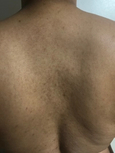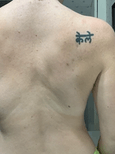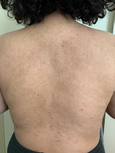Clogged Pores
klaagd -porzClogged pores are filled with a buildup of sebum (oil), dead skin cells, bacteria, and other minuscule debris, like makeup.
Also Called
Whiteheads, blackheads, acne, pimples
Frequently Found On
Back, chest, arms

What are clogged pores?
Clogged pores are pores with a buildup of oil and dead skin cells, and potentially other miniscule debris, like dirt and makeup. Because pores are constantly producing oil (sebum) that keeps the skin moisturized and protected, and the skin is constantly producing and shedding keratin (more skin), clogged pores are extremely normal. They’re especially common in oilier skin types, and in adolescence or any time the body is going through hormone fluctuation that sets off more oil production. Certain diseases, medications, and stress can set off oil production in the skin, leading to clogged pores.
“Clogged pores are the first step to becoming acne,” says Dr. Tiffany Libby, a board-certified dermatologist and dermatologic surgeon in Providence, Rhode Island. A skincare regimen of regular cleansing and gentle exfoliation can help clear clogged pores before developing into acne, but sometimes there’s no controlling the universe. Pimples happen.
Clogged pores occur in varying degrees of just-how-clogged-is-it, from small specks visible only when you lean in really close to the mirror—these are called sebaceous filaments—or deeply imbedded, large blackheads that need to be extracted by a professional.1

Clogged pores, known medically as comedones, might develop into acne as flesh-colored bumps, “whiteheads,” though they’re not always white.2 Whiteheads occur when new skin forms over the clogged pore. Clogged pores can evolve into a blackhead (“open comedone”) when the whitehead breaks the surface of the skin to make room for all the stuff clogging it. When that oil-dead skin mix is exposed to the open air it oxidizes, turning brown or black. If a clogged pore gets even further clogged with bacteria, it becomes irritated, inflamed, and ruptures: a pimple is born.
What causes clogged pores?
Clogged pores are caused by a combination of built-up oil (sebum), dead skin, and bacteria. People with oily skin types are therefore more prone to clogged pores. Because hormones control the skin’s oil production, teenagers, pregnant women, or anyone going through hormonal fluctuation is more prone to oily skin, clogged pores, and resulting acne. Certain diseases, medications, and stress can set off oil production in the skin, too.
Comedogenic vs. Non-comedogenic
In skincare, thick creams, coconut oil, and other “comedogenic” ingredients can clog pores. Products labeled “non-comedogenic” have undergone a simple test wherein a dermatologist observes the condition of the pores of a test subject after using the product. No blackheads?: “non-comedogenic.” It’s important to note that there is no governing body to ensure the consistency and validity of these tests, so your best bet is to look for formulas with a thinner consistency, and take it easy when introducing new products into your routine so that you can best assess how your skin reacts.3
Physical Elements
A few physical elements can lead to clogged pores, like hats, helmets, head coverings, bangs, masks, hair products close to the face, and touching your face with your hands, which can transfer oil or trap it in further. “If I have a patient who I notice is only getting forehead acne and they’re always wearing a hat,” notes Dr. Libby, “I’ll ask them to not wear their hat or clean their hat more regularly.” Identifying the cause of your clogged pores can help dictate the treatment best suited for your skin, so before diving into a new 15-product routine, talk to a dermatologist to get the best personalized advice.
How do you treat clogged pores?
Cleanse
Treating clogged pores can be as simple as cleansing twice daily with a cleanser appropriate for your skin type. A further step would be cleansing with a wash that contains pore-clearing salicylic acid, which “loves oil,” per Dr. Libby (it’s a beta hydroxy acid, which is an acid that dissolves in oil). For skin types on the sensitive side, using a cleanser with salicylic once, or a few times a week might be enough; or even that might be too drying and a gentle cleanser might be a better fit.4 For oilier skin types, cleansing might be the first step in a routine that includes retinoids, exfoliants, and the occasional peel to shed dead skin cells. Talking to a dermatologist for a personalized plan before you buy half the drugstore aisle is the right move.
Exfoliate
A secondary step to treating clogged pores is adding a chemical exfoliant treatment like salicylic acid, glycolic acid, anything labeled AHA or BHA, or retinoid, after cleansing, usually in the form of a toner or moisturizer.4 Those ingredients sound intense and medical, but they’re gentler on the skin than harsh physical scrubs as they help clean out the pores on a microscopic level. “By drawing out oil and by ridding the pore of dirt, makeup, and debris, you’re essentially allowing the pore to go back to its smallest size,” explains Dr. Libby. Most importantly: “You’re getting junk out of the pore.”
These acids usually perform a few duties while they’re at it, softening the skin, targeting bacteria, and removing (some, but not all) oil deep within the pore. Dermatologists love retinoids, says Dr. Libby, because they “minimize pore sizes and increase cell turnover. So you’re getting rid of some debris and the dead skin cells on top, minimizing sebum production, and treating acne. And then you improve your skin elasticity by amping up collagen production with the retinoid too.”
However, these acids and retinoids can be drying and irritating, so depending on your skin type, you may want to ease into chemical exfoliation once a week and work up to more. Those with sensitive skin can also seek out products with less potency, like a toner with .5% salicylic acid instead of 2%, (or products labeled for sensitive skin, or “gentle”).
Avoid Extractions
Extracting blackheads specifically is an almost surgical process, requiring sanitary, careful work, and best handled by a dermatologist or aesthetician. “People tend to use their fingers and that’s going to cause more irritation,” warns Dr. Libby, “And sometimes in doing so, they irritate the skin surrounding it. It usually doesn’t end well.” Just don’t.
Mass Index Recommends:

Soft Services
Clearing Clay
$28
8 oz
maximum strength
10% sulfur wash, mask, and spot treatment that gently exfoliates dead skin cells, allowing anti-acne, anti-breakout, anti-discoloration, and soothing ingredients to penetrate.

Skinfix
Resurface+ Glycolic Renewing Scrub
$30
8 oz
pre-shower scrub
Scrub that’s applied before showering to let the chemical exfoliants—glycolic and lactic acids—penetrate the skin to clear away dead skin, oil, and bacteria that can lead to clogged pores.

Soft Services
Clearing Mist
$26
4 fl oz
acne treatment
Salicylic acid treats acne with niacinamide for hyperpigmentation, boosted by zinc PCA and tea tree oil’s antimicrobial and antifungal properties.
Soft Services works with experts to review the accuracy of our content, but they do not endorse the products we made.
How do you prevent clogged pores?
The best way to prevent clogged pores is to cleanse regularly, which will clear out the build-up of oil in your pores. For an extra step, after cleansing, applying chemical exfoliators like salicylic acid or glycolic acid (also labeled AHA or BHA) will help clear out excess oil and dead skin cells, both of which contribute to clogged pores and subsequent breakouts. Topical retinoids also help by turning over skin cells before they get a chance to clog the pores.
Prescription retinoids, like Tretinoin, can reduce oil production and be effective for people with severe acne, but are probably not necessary for someone trying to fight the occasional breakout. Beyond skincare, avoid touching your face, which transfers oils. Hats, sunglasses, bangs, bedsheets in need of a wash, masks, and head coverings are all culprits for clogged pores. At some point, though, it’s important to remember that the skin is producing oils to keep itself hydrated, so overdoing the attempt to get rid of that oil can end up drying or irritating the skin—and you’re back at square one.
Citations
1Sebaceous filaments by G Plewig and H H Wolff. Arch Dermatol Res.
2Treatment Modalities for Acne by Lizelle Fox, Candice Csongradi, Marique Aucamp, Jeanetta du Plessis, and Minja Gerber. Molecules.
3Clinical utility of marketing terms used for over-the-counter dermatologic products by Emily Boozalis and Shivani Patel. J Dermatolog Treat.
4The effect of a daily facial cleanser for normal to oily skin on the skin barrier of subjects with acne by Zoe D Draelos. Cutis.
5The effect of physically applied alpha hydroxyl acids on the skin pore and comedone by S J Kim, J H Baek, J S Koh, M I Bae, S J Lee, and M K Shin. Int J Cosmet Sci.
Additional References:
A re-evaluation of the comedogenicity concept by Zoe Diana Draelos and Joseph C DiNardo. J Am Acad Dermatol.
Comedogenicity and irritancy of commonly used ingredients in skin care products by James E. Fulton, Jr. j. Soc. Cosmet. Chem.
Cosmetics for acne: indications and recommendations for an evidence-based approach by F Dall'oglio, A Tedeschi, G Fabbrocini, S Veraldi, M Picardo, and G Micali. G Ital Dermatol Venereol.
Enlarged Facial Pores: An Update on Treatments Cutis by Joanna Dong, Julien Lanoue, and Gary Goldenberg.
Facial skin pores: a multiethnic study by Frederic Flament, Ghislain Francois, Huixia Qiu, Chengda Ye, Tomoo Hanaya, et al. Clin Cosmet Investig Dermatol.
Put Your Best Face Forward by Sandra Lee, MD.
Salicylic acid as a peeling agent: a comprehensive review by Tasleem Arif. Clin Cosmet Investig Dermatol.
Get Updates
There’s more to come.
Sign up to receive periodical updates on Mass Index, and to be the first to know when Soft Services launches new products. (If we don’t have any updates, we won’t email you.)























